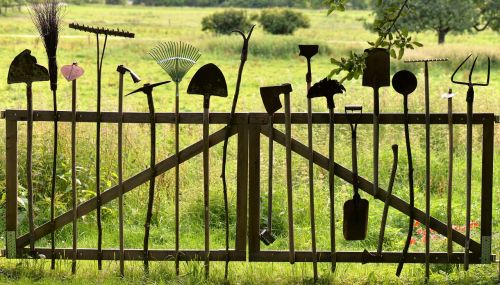
Jobs to do in the garden this Spring in the UK
Share
Here’s our guide to Jobs to do in the garden this Spring in the UK. The guide covers:
-
When is Spring in the UK?
-
How to tidy a garden shed
-
How to clean garden tools
-
Garden tool storage ideas
-
UK Springtime garden calendar (March, April and May)
We’ve included some housekeeping tasks, like tidying up the shed and storing all your garden tools, as well as a calendar for ‘proper’ gardening jobs. It’s only a brief list and a quick reminder and you may need to dig a little deeper (see what we did there!) about some jobs like planting and pruning. We hope you find it useful.

When is Spring in the UK? - typically Spring in the UK starts in March and lasts through May.
However, the exact dates can vary depending on the year and location within the UK. The beginning of spring is marked by the vernal equinox, which usually occurs around March 20th or 21st in the Northern Hemisphere. During spring, the weather in the UK gradually becomes warmer and sunnier, and plants begin to bloom and grow again after the winter months. Spring is an important time for gardening, as it is a good time to plant new crops and flowers, and to prepare your garden for the growing season ahead.

Photo by Chris Linnett on Unsplash
Before you start actually gardening you will get a warm fuzzy feeling if you get everything tidy and organised first. One of the key parts of this is getting your shed sorted out and your garden tools cleaned and ready to use. If your tools are not stored properly, so you can get to them easily (and without whacking yourself in the face with a rake), now is the time to get organised with a garden tool storage rack!
How to tidy a garden shed
Tidying a garden shed can seem like a daunting task, but with a bit of planning and organization, it can be a relatively simple process. Here are some steps you can take to tidy your garden shed:

Photo by Nico Smit on Unsplash
Empty it: The first step is to remove everything from the shed. This will allow you to see what you have, and make it easier to clean the space.
Clean it: Once everything is out of the shed, sweep or vacuum the floors and wipe down any shelves or surfaces. This will remove any dust or debris that may have accumulated over time.
Sort stuff: Go through everything you've taken out of the shed and sort it into piles of things to keep, things to donate or sell, and things to throw away. Be ruthless and only keep what you really need and use.
Organize items: Once you've decided what to keep, group similar items together and put them into storage containers or on shelves. For example, all gardening tools can be placed in one area, while pots and planters can be stored in another.
Use wall space: Take advantage of the vertical space in the shed by installing hooks, shelves, or wall mounted tool racks. This will help keep items off the floor and create more storage space.
Label containers: Use labels or markers to indicate the contents of storage containers. This will make it easier to find what you need when you need it.
By following these steps, you can tidy your garden shed and create a more organized and functional space.
How to clean garden tools
Cleaning your garden tools is important to maintain their effectiveness, extend their lifespan, and prevent the spread of disease between plants. You’ll also save money in the long run. Here are some steps you can take to clean your garden tools this spring:

Photo by Annie Spratt on Unsplash
Gather supplies: You will need a bucket or large container, water, mild soap, a stiff-bristled brush, and a towel or rag.
Remove debris: Use a stiff-bristled brush to remove any dirt, plant matter, or rust from your tools.
Soak in soapy water: Fill a bucket or large container with warm water and mild soap. Soak your tools in the water for a few minutes to help loosen any remaining dirt or debris.
Scrub: Use a stiff-bristled brush to scrub your tools thoroughly, paying extra attention to any crevices or hard-to-reach areas.
Rinse: Rinse your tools with clean water to remove any remaining soap and debris.
Dry: Use a towel or rag to dry your tools thoroughly. Make sure to dry all surfaces, including any crevices or hard-to-reach areas. You can also leave them in the sun and a breeze for a few minutes, but not for too long!
Oil: To prevent rust and keep your tools in good condition, apply a light coating of oil to metal surfaces.
By following these steps to clean your garden tools, you can keep them in good condition and ready for use when you need them.
Garden tool storage ideas
Keeping your garden tools organized and easily accessible is key to maintaining a tidy and efficient garden. Here are some garden tool storage ideas:
Garden tool rack by GearHooks
Tool shed: If you don’t have a garden shed or a garage, consider building or buying a small tool shed to store your garden tools. This can be a great option if you have a large collection of tools and want to keep them all in one place.
Pegboard: Install a pegboard on the wall of your shed or garage and hang your tools from hooks. This allows you to easily see and access each tool. Works best for small, lightweight tools.
Tool rack: Use a tool rack to organize your garden tools. This is a great option for larger tools like rakes and shovels.
Garden cart: A garden cart can be a mobile tool storage solution that allows you to easily transport tools around your garden. Works best in small, paved gardens.
Wall-mounted storage system: A wall-mounted storage system with hooks for all your tools can help you organize a variety of tools and supplies.
GearHooks wall mounted storage in a garage
Bucket tool holder: Use a bucket tool holder to store frequently used tools like hand trowels and pruners. This keeps them easily accessible while working in the garden. Suitable for hand tools only.
Magnetic strips: Install magnetic strips on the wall of your shed or garage and attach metal tools to them. This is a great way to keep small metal tools like scissors and shears organized.
By utilizing these garden tool storage ideas, you can keep your garden tools organized and easy to access.
UK Springtime garden calendar
Which garden jobs should I be doing in the UK in March?

Photo by Gary Bendig on Unsplash
March is the beginning of the gardening season in the UK, as the weather starts to warm up and the days get longer. Here are some garden jobs you can do in March:
Pruning: March is a good time to prune roses, winter-flowering shrubs, and any deciduous shrubs that have finished flowering.
Planting: You can start planting new trees, shrubs, and hedges in March. You can also start sowing seeds indoors for plants that need a longer growing season, such as tomatoes and peppers.
Lawn care: In March, you can start mowing your lawn on dry days, and rake up any dead leaves or debris. You can also start feeding and reseeding your lawn.
Clearing: March is a good time to clear out any dead plants or weeds from your flower beds, and to prepare the soil for planting.
Cleaning: You can clean your garden tools and equipment in preparation for the season ahead. You can also wash your greenhouse to prepare it for new plants.
Composting: You can start adding garden waste to your compost heap, which will help to enrich the soil for planting.
Wildlife care: You can put out food and water for birds and other wildlife in your garden, and clean out any bird boxes or feeders.
These are just a few examples of garden jobs you can do in March. The specific tasks will depend on your individual garden and the weather conditions in your area.
Which garden jobs should I be doing in the UK in April

Photo by Bee Felten-Leidel on Unsplash
April is an exciting time for gardeners in the UK, as the weather starts to warm up and many plants begin to emerge from their winter dormancy. Here are some garden jobs you can do in April:
Planting: April is a great time to plant new trees, shrubs, and perennials in your garden. You can also start sowing seeds directly in the ground for vegetables and annual flowers.
Pruning: If you haven't already done so, you can prune back any dead or damaged wood from trees, shrubs, and roses. You can also shape hedges and prune back any spring-flowering shrubs once they have finished blooming.
Lawn care: In April, you can continue to mow your lawn regularly, and you can also apply a spring fertiliser to encourage healthy growth.
Weeding: You can stay on top of weed growth by hoeing or hand-pulling any young weeds as soon as they appear.
Mulching: Mulching your garden beds with organic matter such as compost, well-rotted manure, or shredded bark can help retain moisture and suppress weed growth.
Pest control: Keep an eye out for any pests such as slugs, snails, and aphids, and take appropriate action to prevent damage to your plants.
Wildlife care: You can continue to put out food and water for birds and other wildlife in your garden, and provide nesting materials for birds.
These are just a few examples of garden jobs you can do in April. The specific tasks will depend on your individual garden and the weather conditions in your area.
Which garden jobs should I be doing in the UK in May

Photo by Alexander Schimmeck on Unsplash
May is a busy time for gardeners in the UK, as the weather warms up and many plants are in full bloom. Here are some garden jobs you can do in May:
Planting: May is a great time to plant summer bedding plants such as petunias, marigolds, and geraniums. You can also plant out any seedlings that you started indoors or in a greenhouse.
Weeding: As the weather warms up, weeds will grow more quickly, so make sure to stay on top of them by hoeing or hand-pulling any young weeds.
Pruning: May is a good time to prune back any spring-flowering shrubs that have finished blooming, as well as any deciduous trees that need shaping.
Lawn care: Continue to mow your lawn regularly, and make sure to water it during dry spells. You can also apply a slow-release fertiliser to keep it looking healthy.
Watering: As the weather gets warmer, make sure to water your plants regularly, especially if you have newly planted trees, shrubs, or perennials.
Harvesting: If you have a vegetable garden, you can start harvesting early crops such as radishes, lettuce, and spinach.
Pest control: Keep an eye out for pests such as aphids, slugs, and snails, and take appropriate action to prevent damage to your plants.
Wildlife care: Continue to provide food and water for birds and other wildlife, and make sure to keep bird baths clean and filled with fresh water.
These are just a few examples of garden jobs you can do in May. The specific tasks will depend on your individual garden and the weather conditions in your area.
Keep checking out this blog as we will update it to include jobs to do in Summer, Autumn and Winter too.
Happy gardening!!
Luis


